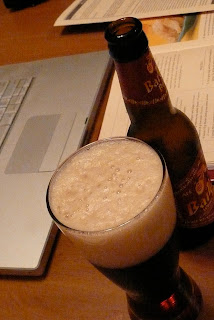Thursday, February 25, 2010
Brasserie Lefebvre Barbar Winter Bok
Tuesday, February 23, 2010
Maui Brewing Co. Big Swell IPA
That being said, Big Swell is a tasty IPA with typical west coast hopping and perhaps a hint of the island flavor where it originates. The malts are a little sweeter than you'd usually find in an IPA of this nature, but it does not hinder the hopping, which is a light grapfruit pine. The hops are present without standing out significantly. They drop off into the sweet malts that for some reason make me think of pineapple. Not necessarily my favorite hop levels, but it pulls it off well and is an amazingly drinkable beer. I could also go for some stronger aroma and head. 6.2%
Thursday, February 18, 2010
Jackie Brown
Tuesday, February 16, 2010
Wild Boar Chili
4 lbs wild boar shoulder, cubed
1 medium onion, diced
7 cloves garlic, chopped
3/4 cup ancho chile powder
1/4 cup cumin
1 tsp chile de arbol
1 tbsp chile mulato
1 bottle dark beer
10-oz can crushed tomatoes
1 cup blackstrap molasses
1/2 cup pineapple juice
4 bay leaves
1-1/2 cups chicken stock
Salt and pepper
1/2 cup unsweetened cocoa powder
1 cup brewed espresso
Here are some pictures from making the chili and the party that followed.
Thursday, February 11, 2010
Pliny the Younger
I exchanged emails with Vinnie from Russian River and found out that the beer was shipped down this way on Tuesday and should be on tap soon. Apparently, at many bars for San Francisco Beer Week it sold out very fast; like in an under an hour fast.
I'll send some pictures to the blog when I get my glass, but in the meantime, here's where you can look for it in Los Angeles:
Verdugo: Tapped tonight at 7pm
Daily Pint: Taps tomorrow 2/12 at 7pm
Library Alehouse: Taps Tuesday, 2/16 at 4pm
Blue Palms: Just announced that they will tap Wednesday, 2/17 at 7pm
See you there.
Warsteiner Dunkel



Tuesday, February 9, 2010
Avery Salvation Belgian-style Golden Ale

Salvation. A lofty name for this Belgian styled Golden Ale from the folks at Avery.
According to the bottle, "Salvation is about finding your true passion, purpose, and meaning in life." I applaud the interpretation, however, if I were to take the word by historical connotation alone, and in some act of Divine Providence, be granted eternal life, I'm not sure this is the beer I would take with me.
Not that this beer is bad, but of course I would bring an American style ale with me! Aromas are sweet honey and malts, reminds me of Midas Touch. The flavor is unmistakebly Belgian in its yeast and grain choices. This would qualify as simply a well made Belgian if it were not for the subtle use of hops that distinguises it from its Flemmish cousins.
I made sure to take a snap shot of their extra fancy foil label.
Avery has cleverly cradled a soft, fruity body in a thin hop shell that rounds out the flavor, keeping the sweet tones from expanding too far. At the same time, the smallest hint of hop bitterness that I've ever tasted seems to pierce the middle of the flavor, perhaps like Moses parting the Red Sea??? Apologies, but broad concepts like Salvation, are best described with broad comedy; so it is and so it shall be. Avery used Belgian candy sugar for flavoring and fermenting, it's a classy and tasty touch. Alc. 9%
Salvation: ***
Wednesday, February 3, 2010
My top 5 Porters






































